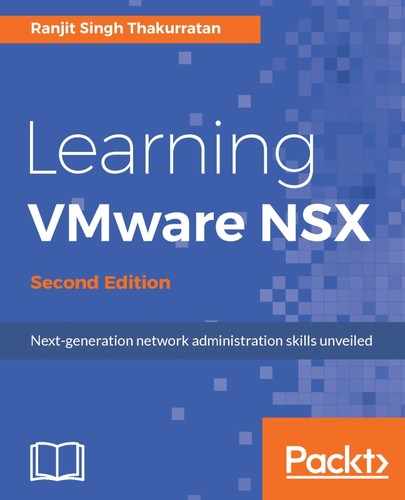The Edge services gateway supports OSPF, BGP, and IS-IS routing protocols. An Edge services gateway can learn and advertise routes when configured with the OSPF routing protocol. When there are routes of equal cost, OSPF provides dynamic load balancing between these routes. The routing table size can become a challenge and an OSPF network limits the size of these routing tables by dividing the network into routing areas to optimize traffic flow. An area is identified by an area ID and is comprised of routers, links, and a logical collection of OSPF networks that have the same area identification.
Before we begin, ensure that a Router ID is configured. As we learned earlier, a Router ID is simply an uplink interface for the Edge services gateway that connects to the external peer. Perform the following set of steps to configure a Router ID:
- Log in to NSX and navigate to Home | Networking & Security | NSX Edges, and double click on the Edge services gateway, and then go to the Manage | Routing | OSPF:

- Click Edit to Enable OSPF configuration:

- Click Enable OSPF. Enable Graceful Restart allows for non-stop packet forwarding even if the OSPF process is being restarted. This helps in non-disruptive packet routing.
- If you want your Edge services gateway to advertise itself as a default gateway to its peers, click OK when done.
- We need to configure OSPF areas. By default, Area 51 is configured, which can be deleted if needed.
- Click the + icon to add a new area:

- Type in an Area ID—it can be an IP address or a decimal number. If your area contains a specific network segment, you can type in 192.168.1.0 to easily identify that area. Next, select the Type of area—Normal or NSSA. NSSA stands for Not-So-Stubby Area. NSSA prevents the flooding of external autonomous system link state advertisements by relying on the default routes to external destinations. NSSAs are typically placed at the Edge of an OSPF routing domain.
- Next, select the type of Authentication. This is optional, but once set you need to ensure that all routers in the area have the same authentication type set with the same password. For MD5 authentication, both receiving and transmitting routers must have the same key configured. Click OK when done.
- Now that we have an area defined, we will proceed to map an interface to that area. In the New Area to Interface Mapping, click the + icon:

- Select the interface and the Area ID to map. There are optional Advanced settings that can be changed. The Hello Interval is the default interval between the hello packets sent to the interface. The Dead Interval is the time out interval before the router declares a neighbor down. The Priority is the default routing priority for the interface. Finally, the Cost of the interface displays the default overhead required to send packets over that interface. You can define the cost based on bandwidth on an interface so that the Edge can determine what the lowest cost to route traffic across multiple interfaces is. The higher the bandwidth on an interface, the lower the cost.
- Click OK when done.
- Click Publish Changes when done.
